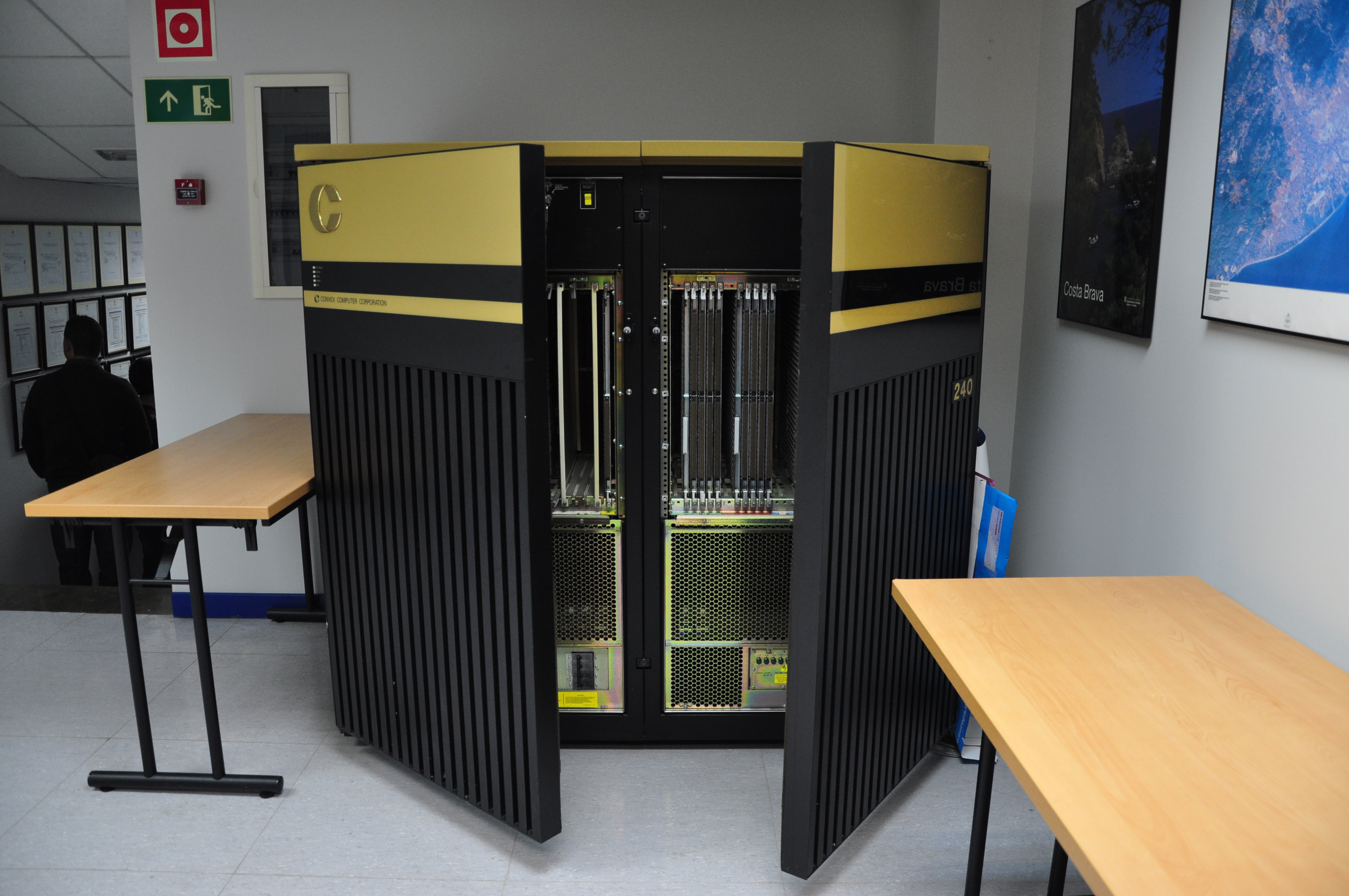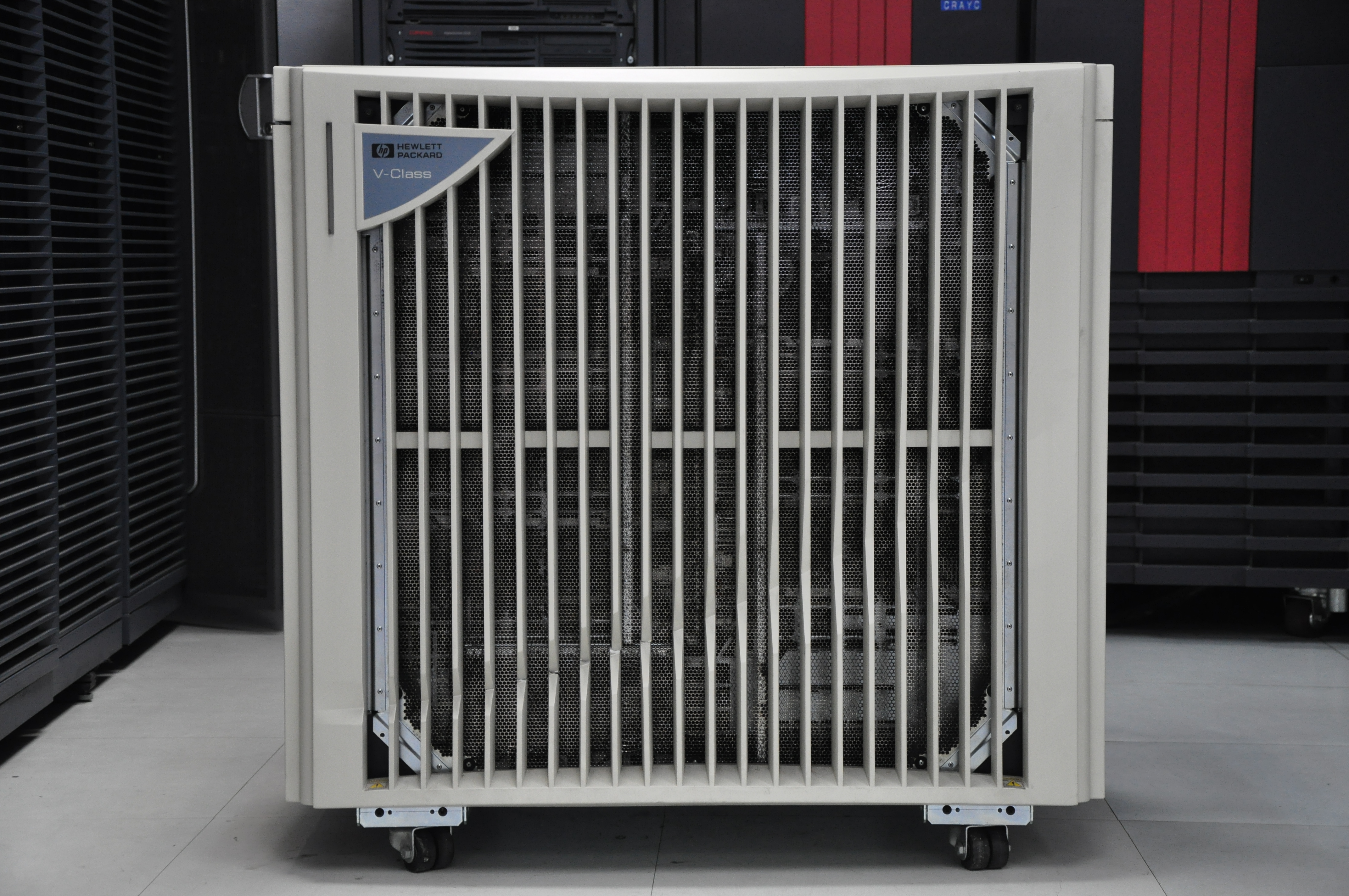Convex Computer on:
[Wikipedia]
[Google]
[Amazon]
Convex Computer Corporation was a company that developed, manufactured and marketed
 The C2 was a crossbar-interconnected
The C2 was a crossbar-interconnected  In 1995, Hewlett-Packard bought Convex. HP sold Convex Exemplar machines under the S-Class (MP) and X-Class (CC-NUMA) titles, and later incorporated some of Exemplar's technology into the V-Class machine, which was released running the HP-UX 11.0 release instead of the SPP-UX version which was sold with the S- and X-Class products.
In 1995, Hewlett-Packard bought Convex. HP sold Convex Exemplar machines under the S-Class (MP) and X-Class (CC-NUMA) titles, and later incorporated some of Exemplar's technology into the V-Class machine, which was released running the HP-UX 11.0 release instead of the SPP-UX version which was sold with the S- and X-Class products.
Convex ex-employees website
* {{cite web , last=Faught , first=Danny , url=http://www.tejasconsulting.com/newsletter/2003April-May.html , title=Convex is Dead, Long Live Convex , at=Feature Article , archive-url=https://web.archive.org/web/20030806052446/http://www.tejasconsulting.com/newsletter/2003April-May.html , archive-date=2003-08-06 1995 mergers and acquisitions American companies established in 1982 American companies disestablished in 1995 Companies based in Richardson, Texas Computer companies established in 1982 Computer companies disestablished in 1995 Defunct computer companies of the United States Defunct computer hardware companies Defunct computer systems companies Hewlett-Packard acquisitions Vector supercomputers
vector
Vector most often refers to:
* Euclidean vector, a quantity with a magnitude and a direction
* Disease vector, an agent that carries and transmits an infectious pathogen into another living organism
Vector may also refer to:
Mathematics a ...
minisupercomputer
Minisupercomputers constituted a short-lived class of computers that emerged in the mid-1980s, characterized by the combination of vector processing and small-scale multiprocessing. As scientific computing using vector processors became more popul ...
s and supercomputer
A supercomputer is a type of computer with a high level of performance as compared to a general-purpose computer. The performance of a supercomputer is commonly measured in floating-point operations per second (FLOPS) instead of million instruc ...
s for small-to-medium-sized businesses. Their later Exemplar series of parallel computing
Parallel computing is a type of computing, computation in which many calculations or Process (computing), processes are carried out simultaneously. Large problems can often be divided into smaller ones, which can then be solved at the same time. ...
machines were based on the Hewlett-Packard
The Hewlett-Packard Company, commonly shortened to Hewlett-Packard ( ) or HP, was an American multinational information technology company. It was founded by Bill Hewlett and David Packard in 1939 in a one-car garage in Palo Alto, California ...
(HP) PA-RISC
Precision Architecture reduced instruction set computer, RISC (PA-RISC) or Hewlett Packard Precision Architecture (HP/PA or simply HPPA), is a computer, general purpose computer instruction set architecture (ISA) developed by Hewlett-Packard f ...
microprocessor
A microprocessor is a computer processor (computing), processor for which the data processing logic and control is included on a single integrated circuit (IC), or a small number of ICs. The microprocessor contains the arithmetic, logic, a ...
s, and in 1995, HP bought the company. Exemplar machines were offered for sale by HP for some time, and Exemplar technology was used in HP's V-Class machines.
History
Convex was formed in 1982 by Bob Paluck and Steve Wallach inRichardson, Texas
Richardson is a city in Dallas and Collin counties in the U.S. state of Texas. As of the 2020 United States census, the city had a total population of 119,469. Richardson is an inner suburb of the city of Dallas.
It is home to the Universit ...
. It was originally named Parsec and early prototype and production boards bear that name. They planned on producing a machine very similar in architecture to the Cray Research
Cray Inc., a subsidiary of Hewlett Packard Enterprise, is an American supercomputer manufacturer headquartered in Seattle, Washington. It also manufactures systems for data storage and analytics. Several Cray supercomputer systems are listed i ...
vector processor
In computing, a vector processor or array processor is a central processing unit (CPU) that implements an instruction set where its instructions are designed to operate efficiently and effectively on large one-dimensional arrays of data called ...
machines, with a somewhat lower performance, but with a much better price–performance ratio
In economics, engineering, business management and marketing the price–performance ratio is often written as cost–performance, cost–benefit or capability/price (C/P), refers to a product's ability to deliver performance, of any sort, for i ...
. In order to lower costs, the Convex designs were not as technologically aggressive as Cray's, and were based on more mainstream chip technology, attempting to make up for the loss in performance in other ways.
Their first machine was the C1, released in 1985. The C1 was very similar to the Cray-1
The Cray-1 was a supercomputer designed, manufactured and marketed by Cray Research. Announced in 1975, the first Cray-1 system was installed at Los Alamos National Laboratory in 1976. Eventually, eighty Cray-1s were sold, making it one of the ...
in general design, but its CPU and main memory was implemented with slower but less expensive CMOS
Complementary metal–oxide–semiconductor (CMOS, pronounced "sea-moss
", , ) is a type of MOSFET, metal–oxide–semiconductor field-effect transistor (MOSFET) semiconductor device fabrication, fabrication process that uses complementary an ...
technology. They offset this by increasing the capabilities of the vector units, including doubling the vector registers' length to 128 64-bit
In computer architecture, 64-bit integers, memory addresses, or other data units are those that are 64 bits wide. Also, 64-bit central processing units (CPU) and arithmetic logic units (ALU) are those that are based on processor registers, a ...
elements each. It also used virtual memory
In computing, virtual memory, or virtual storage, is a memory management technique that provides an "idealized abstraction of the storage resources that are actually available on a given machine" which "creates the illusion to users of a ver ...
as opposed to the static memory system of the Cray machines, which improved programming. It was generally rated at 20 MFLOPS peak for double precision (64-bit), and 40 MFLOPS peak for single precision (32-bit
In computer architecture, 32-bit computing refers to computer systems with a processor, memory, and other major system components that operate on data in a maximum of 32- bit units. Compared to smaller bit widths, 32-bit computers can perform la ...
), about one fifth the normal speed of the Cray-1. They also invested heavily in advanced automatic vectorizing compiler
In computing, a compiler is a computer program that Translator (computing), translates computer code written in one programming language (the ''source'' language) into another language (the ''target'' language). The name "compiler" is primaril ...
s in order to gain performance when existing programs were ported to their systems. The machines ran a BSD
The Berkeley Software Distribution (BSD), also known as Berkeley Unix or BSD Unix, is a discontinued Unix operating system developed and distributed by the Computer Systems Research Group (CSRG) at the University of California, Berkeley, beginni ...
version of Unix
Unix (, ; trademarked as UNIX) is a family of multitasking, multi-user computer operating systems that derive from the original AT&T Unix, whose development started in 1969 at the Bell Labs research center by Ken Thompson, Dennis Ritchie, a ...
known initially as Convex Unix then later as ConvexOS due to trademark and licensing issues. ConvexOS has DEC VMS compatibility features, known by the product name of COVUE (CONVEX-to-VAX User Environment), as well as Cray Fortran features. Their Fortran compiler went on to be licensed to other computers such as Ardent Computer Stardent Computer, Inc. was a manufacturer of graphics supercomputer workstations in the late 1980s. The company was formed in 1989 when Ardent Computer Corporation (formerly Dana Computer, Inc.) and Stellar Computer Inc. merged.
Both of the found ...
and Stellar (and merged Stardent).
multiprocessor
Multiprocessing (MP) is the use of two or more central processing units (CPUs) within a single computer system. The term also refers to the ability of a system to support more than one processor or the ability to allocate tasks between them. The ...
version of the C1, with up to four CPUs, released in 1988. It used newer 20,000-gate CMOS and 10,000-gate emitter-coupled logic
In electronics, emitter-coupled logic (ECL) is a high-speed integrated circuit bipolar transistor logic family. ECL uses a bipolar junction transistor (BJT) differential amplifier with single-ended input and limited emitter current to avoid th ...
(ECL) gate arrays for a boost in clock speed from 10 MHz to 25 MHz, and rated at 50 MFLOPS peak for double precision per CPU (100 MFLOPS peak for single precision). It was Convex's most successful product.
The C2 was followed by the C3 in 1991, being essentially similar to the C2 but with a faster clock and support for up to eight CPUs implemented with low-density GaAs FPGAs. Various configurations of the C3 were offered, with 50 to 240 MFLOPS per CPU. However, the C3 and the Convex business model were overtaken by changes in the computer industry. The arrival of RISC
In electronics and computer science, a reduced instruction set computer (RISC) is a computer architecture designed to simplify the individual instructions given to the computer to accomplish tasks. Compared to the instructions given to a comp ...
microprocessors meant that it was no longer possible to develop cost-effective high-performance computing as a standalone small low-volume company. While the C3 was delivered late, which resulted in lost sales, it was still not going to be able to compete with commodity high-performance computing in the long run.
Another speed boost used in the C3 and C4, which moved the hardware implementation to GaAs
Gallium arsenide (GaAs) is a III-V direct band gap semiconductor with a zinc blende crystal structure.
Gallium arsenide is used in the manufacture of devices such as microwave frequency integrated circuits, monolithic microwave integrated circui ...
-based chips, following an evolution identical to that of the Cray machines, but the effort was too little, too late. Some considered the whole C4 program to be nothing more than chasing a business in decline. By this time, even though Convex was the first vendor to ship a GaAs based product, they were losing money.
In 1994, Convex introduced an entirely new design, known as the Exemplar. Unlike the C-series vector computer, the Exemplar was a parallel-computing machine that used HP PA-7200 microprocessors, connected together using SCI. First dubbed MPP, these machines were later called SPP and Exemplar and sold under the SPP-1600 moniker. The expectation was that a software programming model for parallel computing could draw in customers. But the type of customers Convex attracted believed in Fortran and brute force rather than sophisticated technology. The operating system also had terrible performance problems which could not easily be fixed. Eventually, Convex established a working partnership with HP's hardware and software divisions. Initially it was intended that the Exemplar would be binary-compatible with HP's HP-UX
HP-UX (from "Hewlett Packard Unix") is a proprietary software, proprietary implementation of the Unix operating system developed by Hewlett Packard Enterprise; current versions support HPE Integrity Servers, based on Intel's Itanium architect ...
operating system but eventually it was decided to port HP-UX to the platform and sell the platform as standalone servers.
References
External links
Convex ex-employees website
* {{cite web , last=Faught , first=Danny , url=http://www.tejasconsulting.com/newsletter/2003April-May.html , title=Convex is Dead, Long Live Convex , at=Feature Article , archive-url=https://web.archive.org/web/20030806052446/http://www.tejasconsulting.com/newsletter/2003April-May.html , archive-date=2003-08-06 1995 mergers and acquisitions American companies established in 1982 American companies disestablished in 1995 Companies based in Richardson, Texas Computer companies established in 1982 Computer companies disestablished in 1995 Defunct computer companies of the United States Defunct computer hardware companies Defunct computer systems companies Hewlett-Packard acquisitions Vector supercomputers